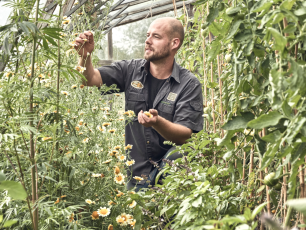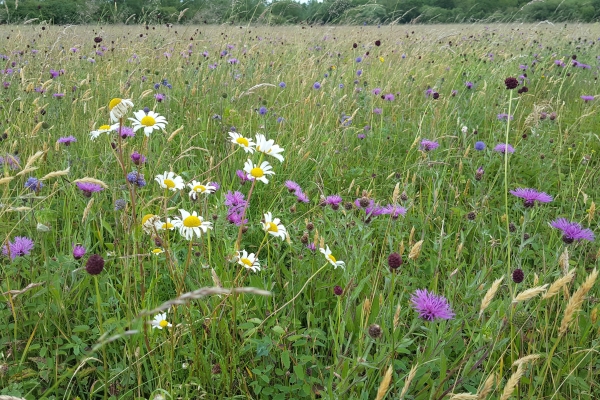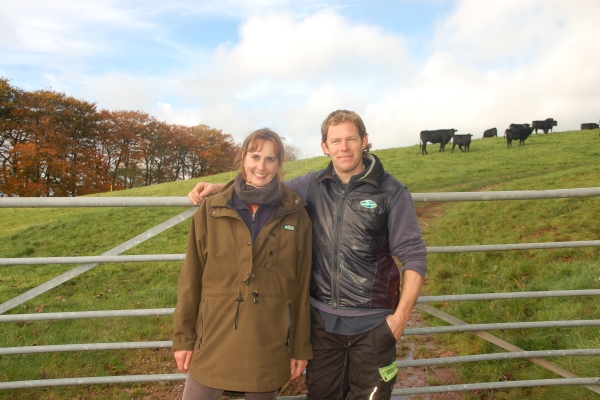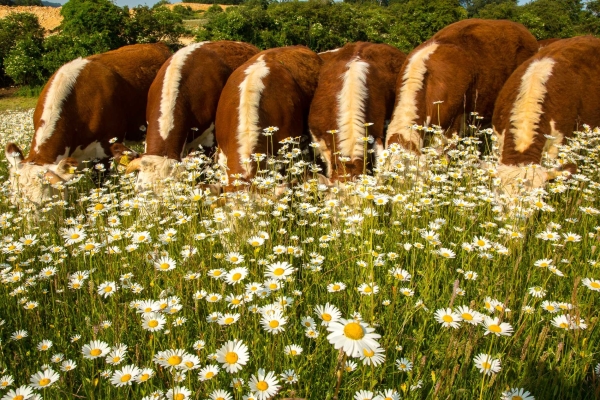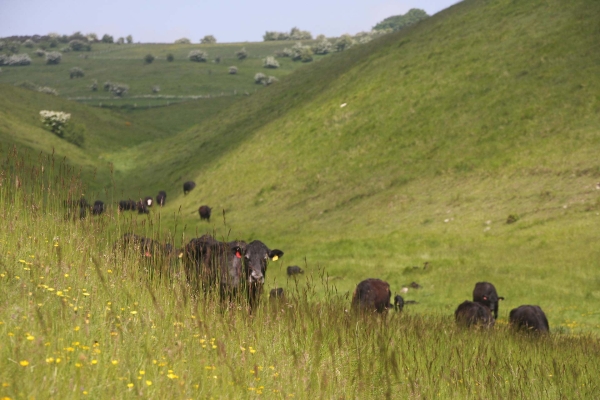Bale Grazing at Treflach Farm
After a couple of days let up from the seemingly never-ending rain, we visited Treflach farm on the Welsh / Shropshire border on 8th March 2024, for a Pasture for Life (PfL) field day about bale grazing and overwintering strategies.
Treflach Farm is a family-run farm, headed up by Ian and Stef Steele, that describes its approach as “transitioning towards sustainable farming by learning, practicing and demonstrating techniques guided by holism and grounded in permaculture principles.” Since 2006 Ian has been working to revitalise the hillside farm that has been family owned since 1904. Formerly a diary operation, the farm now raises British Friesian / Hereford cross cattle, free range Tamworth pigs, keeps bees, runs a butchery and bakery (making fantastic pies), has a farm shop, grows a range of vegetables, and offers educational projects for adults with learning difficulties, children with behavioural problems, and local schools.
With the Steeles having undertaken a course in holistic management, the activities on the farm are guided by a set of 5 principles as they look to deliver their vision of agriculture as a sustainable industry that is rooted in the community, working in harmony with nature, and providing for the needs of local people:
- Becoming and remaining socially and economically viable and relevant to the community we serve.
- Putting in place the opportunities for developing an aspirational quality of life.
- Increasing biodiversity and building soil.
- Farming using ultra-high animal welfare methods.
- Moving toward a circular economy.
You can read the farm’s full manifesto here.
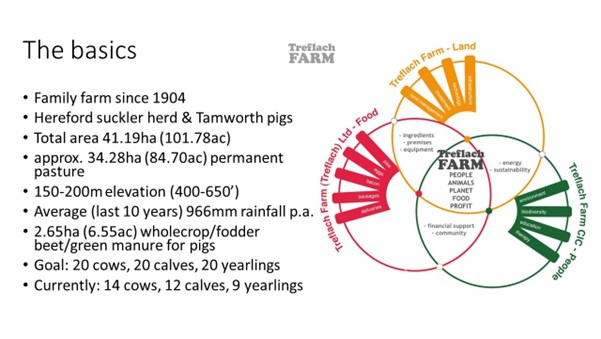
Working to rejuvenate the farm, they’re learning as they go. Ian flagged that it’s the cattle who are teaching them and there’s still plenty of user error seen in their systems. Being a PfL member has significantly helped as the advice from the organisation and within the network has allowed them to be better at what they do and challenge their own processes regularly.
They currently cull one beef steer a month, which gets used in their bakery products, and they are aiming to build the heard up so that they can cull 24 animals a year. This will provide all the beef requirements for the bakery. Alongside this, they raise around 60-80 piglets a year, which are used in the farm shop and the bakery products.
Ian is part of a group of PfL farmers that are involved in an Innovative Farmers Field Lab looking in to bale grazing. Bale grazing is becoming more common in the UK, it is a low cost strategy for overwintering cattle, where hay or silage is cut in the autumn and put into the fields where it will be accessed by the animals through the winter. The bales can be grazed in situ or can be rolled out for cattle to graze. The field lab is looking into effects bale grazing can have on soil health and forage quality where the bales have been grazed.
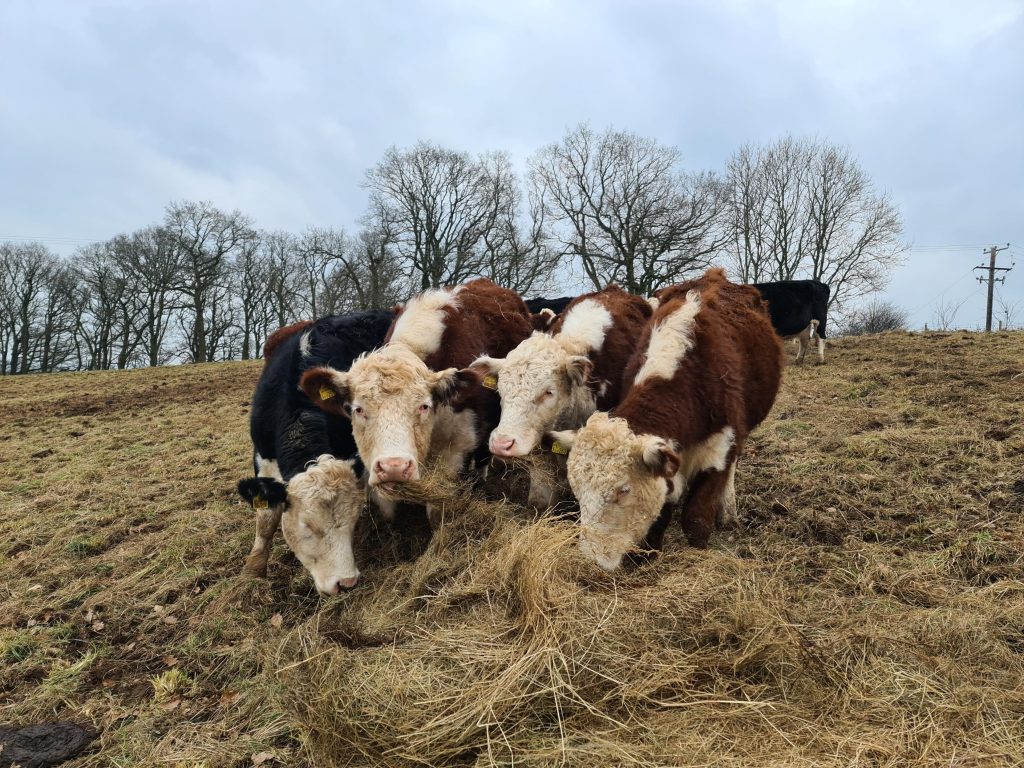
When Ian first took over running the farm, the cattle were housed over winter. He started extending the grazing season as he looked to change the farm management. He started adopting bale grazing because of the significant amount of work required to keep the cattle housed over winter and the additional work required in the summer to manage forage production.
The following issues associated with housing livestock over winter were highlighted:
- Cost of harvesting
- Cost of storage of forage and bedding
- Cost of feeding (diesel and machinery)
- Cost of new housing for increased number of animals
- Manure storage, handling and spreading
- Animal health
The herd is split into two, with yearlings and calves grazing in one area, and the in-calf cows and bull in another (see below).
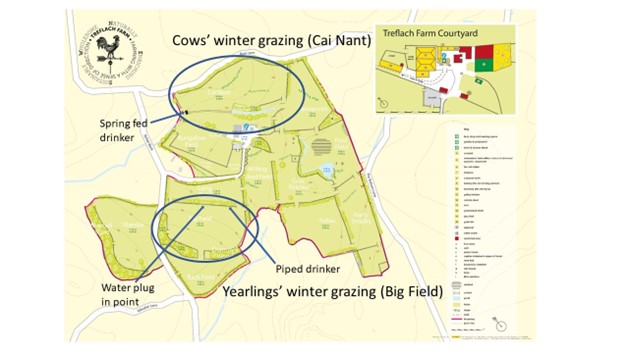
For the yearlings and calves, all their bales are put out on to a ridge after being harvested in mid to late July and are left out across autumn and winter. Bales cut earlier in the year can be left out in the fields with only a small amount of spoilage being seen on the outside couple of inches and a touch of rot at the bottom. Where the cows are out-wintered, Ian has access to the field with machinery and places the bales out as required. Due to this mixed strategy for putting bales out, he is now storing those early cut bales and using them in the cow’s fields.

The fields used for bale grazing over winter are chosen because they have shelter for the animals, there is water access, and they have hills (it’s useful to have gravity help roll out the bales!). Bales are positioned at 90 degrees to the slope to ensure they don’t roll down and are manually turned before being rolled out.
Using electric fencing that is moved every 2 days, the cattle access fresh grass and a bale as they move across the field. Depending on the weather, Ian sometimes back-fences but doesn’t worry too much about this as the cattle tend to stay on the freshly released grass.

For working out forage requirements Ian looks at number of bales, size of field, live weight of the stock, and daily dry weight matter needs (see bale grazing plans below).


Ian highlighted that it is clear to see that the way they control the livestock through paddock grazing and overwintering is better for the animal, better for soil health, and better for the farmer. They are seeing more biodiversity in their pastures – Ian emphasised that the diversity was already there, but it’s more evident due to management changes.
One of the starkest things observed during the day was despite all the rain we have experienced this winter, the fields we visited where the cattle have been overwintered were remarkably dry, not a quagmire as you might expect. Ian attributed this to the paddock grazing system that has been in operation for 10 years. He commented that the ground never used to be like this, in the past it wouldn’t dry out quickly and would become unpassable in the winter. The bale grazing isn’t the reason for this, but it is part of the wider strategy that allows them to keep livestock out over winter, cut costs and continue to improve the health of the farm, the business, and the animals.


